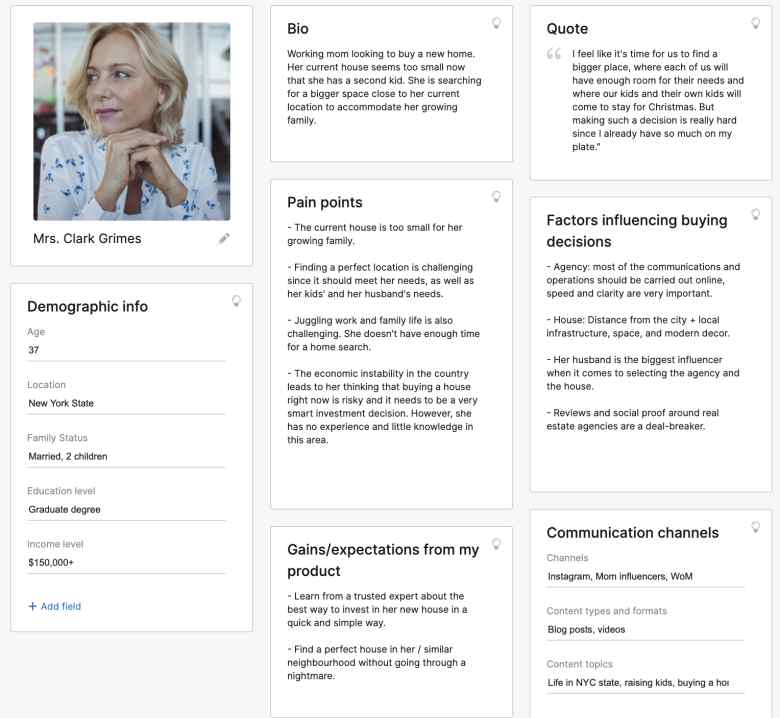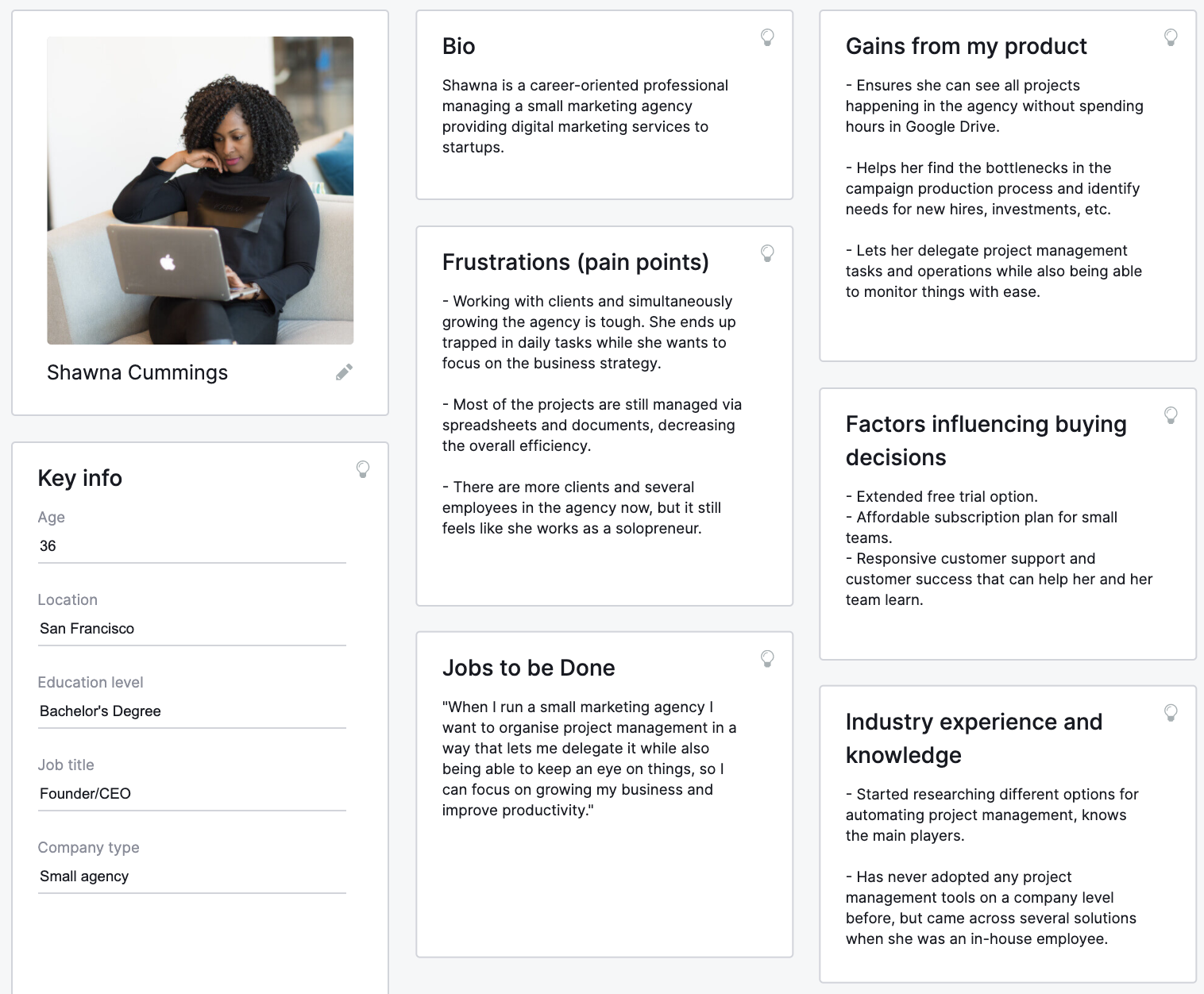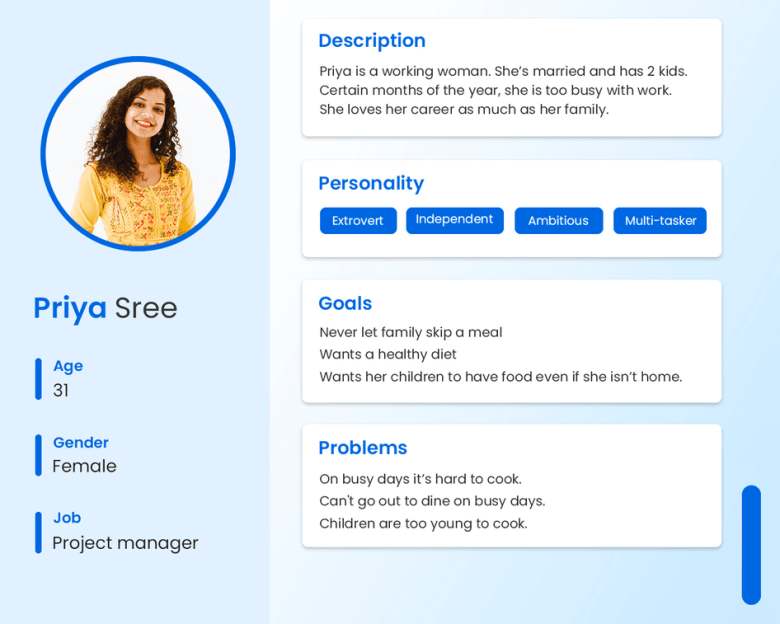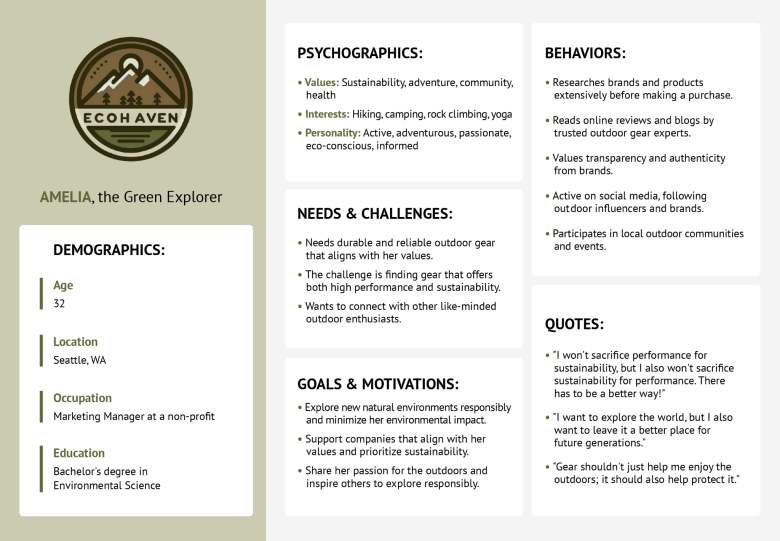Customer Persona Generator (+ AI Prompts and Templates)
For busy marketing managers, finding your target market has never been easier! In this guide, we’ll share AI prompts, FAQs, and our battle-tested best practices to help you identify your target customers, faster and easier.
How to Use Our Customer Persona Generator
Just answer a few questions about your business or product, and fill in as much as you know about your target customer. Our AI Customer Persona Generator will identify your target customer in rich and vivid detail.
Remember: the more information you give it, the better your customer persona will get. You can keep refining it until you’re happy with the results — then have the final results emailed to you.
More Prompts for Refining Your Target Market
Once you’ve generated your draft above, here are further AI prompts for refining the results.
- Learn about the Person:
List potential hobbies and interests for these customer personas. - Learn about the Professional:
Detail the professional life, including job title and daily responsibilities, of these customer personas. - Learn about the Psychographics:
Describe the values, fears, and aspirations of these personas. - Understand Behavior:
Illustrate the daily behaviors and online browsing habits of these personas. - Improve Tone and Style:
Rewrite this persona description to sound more formal/playful/sophisticated/etc. - Create Persona Backstories:
Craft a brief backstory for these personas. - Explore Familiarity Factors:
Describe the technology comfort level and preferred gadgets of these personas. - Discover Engagement Enablers:
List the potential factors that would motivate these personas to purchase our product.
Great Examples of Customer Personas
B2C Customer Persona Example (Real Estate Firm)
 Image Source: SemRush
Image Source: SemRush
This is an example of a customer persona for a real estate firm. It provides a solid foundation for B2C real estate businesses to understand and target working moms. Here is what makes it effective:
- Clearly defined audience: Focuses on “working mom looking to buy a home,” creating a specific target audience.
- Relatable pain points: This section captures challenges this demographic faces, such as space needs, location struggles, time constraints, and economic concerns.
- Quantifiable goals: Mentions her desire for a bigger house, location preferences, and quick & simple solutions.
- Actionable insights: Highlights communication preferences (online, fast, clear), desired outcomes (expert guidance, ideal location), and influencer factors (husband, reviews, etc).
- Data-driven context: Includes age, marital status, and number of children for demographic understanding.
- Compelling quote: Makes the persona feel real and relatable by expressing emotional needs and goals.
B2B Customer Persona Example
 Image Source: SemRush
Image Source: SemRush
This B2B customer persona example is ideal for businesses offering business management tools and can be effective for several reasons:
- Clearly defined target audience: The persona focuses on a specific niche – owners of small marketing agencies, making it more relatable and actionable.
- Compelling pain points: It highlights real challenges these professionals face, like juggling client work and agency growth, which can lead to inefficiency and a solopreneur feeling.
- Specific “Jobs to be Done” framework: It uses the Jobs to be Done framework, clearly stating her context, desired outcome, and expected gains from your product.
- Benefits tailored to her needs: The product’s benefits directly address her pain points: better project overview, identifying bottlenecks, and easier delegation.
- Decision-making factors considered: Understanding the factors vital to her, like affordability, free trial, and customer support, shows alignment with her needs.
- Industry knowledge and experience: It establishes her awareness of different options while highlighting her need for agency-wide implementation experience, creating an opportunity for your product to be the solution.
3. Swiggy App Customer Persona Example
 Image Source: Crayon’d
Image Source: Crayon’d
Swiggy is a popular online food and grocery delivery platform operating in over 500 cities across India. The Swiggy App provides a convenient and comprehensive platform for food and grocery delivery, offering convenience and variety for its users. This Customer persona for the Swiggy App is compelling for the following reasons:
- Targeted audience: It focuses on busy professionals, aligning with Swiggy’s core user base.
- Relatable persona: Describing Priya’s occupation, age, family situation, and personality makes her more relatable.
- Clear goals and challenges: The target audience resonates with her desire to provide healthy meals and avoid cooking on busy days.
- Specificity: Mentioning her age and marital status provides some demographic context.
- Specific Pain Points: Detailing her cooking challenges, dietary preferences, and family concerns strengthens her emotional connection with potential users.
See more examples here.
AI Example of Customer Persona
Company: EcoHaven – Sustainable Outdoor Gear
EcoHaven specializes in high-quality outdoor gear designed for eco-conscious adventurers. From backpacks made from recycled materials to tents powered by solar panels, their products prioritize sustainability without compromising performance. The company targets environmentally responsible individuals passionate about exploring the outdoors while minimizing their impact on the planet.

10 Best Practices for Creating Customer Personas
- Gather Real Data: Use real customer data, surveys, and interviews as the foundation for each persona.
- Segment Customers: Group customers by shared characteristics like behaviors, demographics, and purchasing patterns.
- Prioritize Depth: Focus on creating a few detailed personas instead of many superficial ones.
- Explore Psychographics: Go beyond demographics to include values, fears, aspirations, and lifestyles.
- Map Empathy: Understand and document what your customer thinks, feels, sees, says, and does.
- Maintain Consistency: Ensure a uniform format across all personas for easy comprehension and comparison.
- Map the Journey: Include the customer’s path from awareness to purchase.
- Revise Regularly: Regularly revisit and refine personas as market conditions, products, and audiences evolve.
- Engage Stakeholders: Engage with sales, product, and customer service teams for holistic insights.
- Visualize Personas: Use photos, icons, or infographics to make the personas visually engaging and memorable.
Craft targeted campaigns using Media Shower’s expert-driven persona insights. Click to try us out.

Frequently Asked Questions About Customer Personas
What is a customer persona?
A customer persona is a detailed representation of your target audience, including their demographics, interests, and behaviors. It's used to understand better and cater to the needs of potential customers.
Why create customer personas?
Customer personas provide insights into your audience's needs, preferences, and pain points, allowing businesses to effectively tailor products, services, and marketing strategies.
How many customer personas should a business have?
The number varies, but most businesses benefit from 3-5 detailed personas. Only create a few, which can dilute your marketing efforts.
Can I use online tools to generate customer personas?
Yes, there are various online tools (like this one!) that can aid in creating customer personas but always use actual customer data for best results.
How often should I update my customer personas?
Reviewing and updating your personas annually, or when significant changes occur in your product offerings, is a good practice.
Should personas be based only on current customers?
No. While current customers offer valuable insights, consider potential customers and market research to capture a broader audience.
Are demographic details the most critical aspect of a persona?
Demographics are essential, but psychographic details, like values, interests, and fears, often provide deeper insights into customer motivations.
What's the difference between customer segmentation and customer personas?
Customer segmentation divides your audience into groups based on shared characteristics, while personas create a detailed 'fictional' profile representing each segment.
Can I create customer personas without conducting surveys?
While surveys provide valuable direct insights, you can use sales data, customer reviews, and market research to create personas.
How do I ensure my team effectively uses customer personas?
Integrate personas into your marketing and sales strategies, provide regular team training, and keep the personas easily accessible to all relevant departments.
10 Protips for Creating Customer Personas
- Data Synthesis: Merge multiple sources. Combine survey results, analytics data, and sales feedback for a comprehensive persona.
- Persona Evolution: Stay agile with changes. Update your personas as you introduce new products or enter new markets.
- Visual Appeal: Enhance with graphics. Use infographics or icons to represent key persona traits, making them memorable visually.
- Collaboration Boost: Team brainstorming sessions. Encourage inter-departmental sessions to gather diverse insights for persona creation.
- Storytelling Element: Craft engaging backstories. A relatable narrative for each persona can help your team understand and empathize better.
- Emotional Connection: Dive deep into your customers’ feelings. Go beyond surface-level traits to uncover deep-seated emotions and motivations.
- Iterative Approach: Regularly test and refine. As campaigns roll out, analyze results to tweak and improve your personas.
- Feedback Importance: Prioritize customer input. Actively seek feedback from real customers to ensure your personas remain accurate and relevant.
The Media Shower platform lets you draft great customer personas using our AI assistants, then send to our expert creative team to design them into polished, professional personas. Click for a free trial of our platform.


